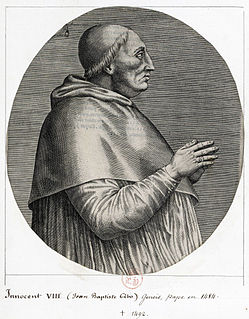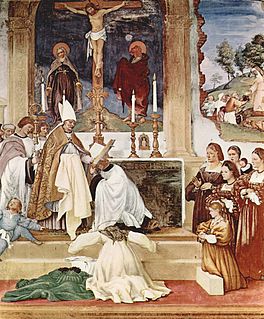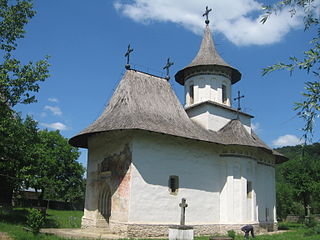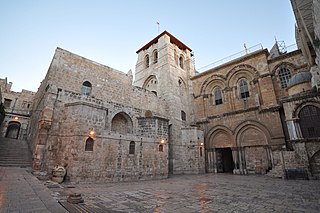
The Church of the Holy Sepulchre is a church in the Christian Quarter of the Old City of Jerusalem. The church contains, according to traditions dating back to at least the fourth century, the two holiest sites in Christianity: the site where Jesus of Nazareth was crucified, at a place known as "Calvary" or "Golgotha", and Jesus' empty tomb, where he is said to have been buried and resurrected. The tomb is enclosed by the 19th-century shrine called the Aedicule (Edicule). The Status Quo, a 260-year-old understanding between religious communities, applies to the site.

In heraldry, Saint George's Cross, also called the Cross of Saint George, is a red cross on a white background, which from the Late Middle Ages became associated with Saint George, the military saint, often depicted as a crusader.

The Crusader states were a number of mostly 12th- and 13th-century feudal Christian states created by Western European crusaders in Asia Minor, Greece and the Holy Land, and during the Northern Crusades in the eastern Baltic area. The name also refers to other territorial gains made by medieval Christendom against Muslim and pagan adversaries.
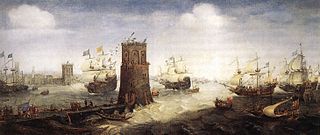
The Fifth Crusade (1217–1221) was an attempt by Western Europeans to reacquire Jerusalem and the rest of the Holy Land by first conquering the powerful Ayyubid state in Egypt.

The Seventh Crusade was a crusade led by Louis IX of France from 1248 to 1254. His troops were defeated by the Egyptian army led by the Ayyubid Sultan Turanshah supported by the Bahariyya Mamluks led by Faris ad-Din Aktai, Baibars al-Bunduqdari, Qutuz, Aybak and Qalawun and Louis was captured. Approximately 800,000 bezants were paid in ransom for his return.

The Equestrian Order of the Holy Sepulchre of Jerusalem, also called Order of the Holy Sepulchre or Knights of the Holy Sepulchre, is a Roman Catholic order of knighthood under the protection of the Holy See. The Pope is sovereign of the Order. Founded as Milites Sancti Sepulcri attached to the Augustinian Canons Regular of the Holy Sepulchre in Jerusalem, recognised in 1113 by Papal bull of Pope Paschal II and of Pope Calistus II in 1122. It traces its roots to circa 1099 under the Frankish Duke Godfrey of Bouillon, Advocatus Sancti Sepulchri, "Defender of the Holy Sepulchre", one of the leaders of the First Crusade and first ruler of the Kingdom of Jerusalem. It is an internationally recognised order of knighthood.

The Order of the Most Holy Trinity and of the Captives, also known as the Order of the Most Holy Trinity or the Trinitarians, is a Catholic religious order founded in Cerfroid, outside Paris, in late 12th century. From the very outset, a special dedication to the mystery of the Holy Trinity has been a constitutive element of the order's life.
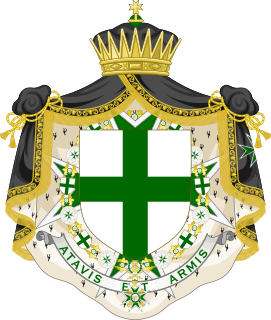
The Order of Saint Lazarus of Jerusalem is a Catholic military order founded by crusaders around 1119 at a leper hospital in Jerusalem, Kingdom of Jerusalem, whose care became its original purpose, named after their patron saint, Lazarus. It was recognised by King Fulk of Jerusalem in 1142 and canonically recognised as hospitaller and military order of chivalry under the rule of Saint Augustine in the Papal bull Cum a Nobis Petitur of Pope Alexander IV in 1255. The titular seat was successively situated at Jerusalem, Saint-Jean-d'Acre and - after the fall of the Kingdom of Jerusalem - split in two main branches in Italy and in Château Royal de Boigny-sur-Bionne in France.
The Canons Regular of the Holy Sepulchre were a Catholic religious order of canons regular of the Rule of Saint Augustine said to have been founded in the Church of the Holy Sepulchre in Jerusalem, then the capital of the Kingdom of Jerusalem, recognised in 1113 by Papal bull of Pope Paschal II. Other accounts has it that they were founded earlier, during the rule of Godfrey of Bouillon (1099–1100).
Norman Housley is a professor of History at the University of Leicester.

The Crusades were a series of religious wars sanctioned by the Latin Church in the medieval period. The most commonly known Crusades are the campaigns in the Eastern Mediterranean aimed at recovering the Holy Land from Muslim rule, but the term "Crusades" is also applied to other church-sanctioned campaigns. These were fought for a variety of reasons including the suppression of paganism and heresy, the resolution of conflict among rival Roman Catholic groups, or for political and territorial advantage. At the time of the early Crusades the word did not exist, only becoming the leading descriptive term around 1760.

The Canons Regular of the Order of the Holy Cross, commonly called Crosiers, are a Roman Catholic religious order.

The Holy Cross Crusaders men's basketball team represents the College of the Holy Cross in Worcester, Massachusetts, in NCAA Division I competition. The team competes in the Patriot League and plays their home games in the Hart Center. The program boasts such notable alumni as Boston Celtics legends Bob Cousy and Tom Heinsohn, and longtime Providence College basketball coach Joe Mullaney.

The Basilica of the Holy Blood is a Roman Catholic basilica in Bruges, Belgium. The church houses a venerated relic of the Holy Blood allegedly collected by Joseph of Arimathea and brought from the Holy Land by Thierry of Alsace, Count of Flanders. Built between 1134 and 1157 as the chapel of the Count of Flanders, it was promoted to a minor basilica in 1923.

The Ecumenical Council is a surrealist painting by Spanish artist Salvador Dalí completed in 1960. It is one of his masterpieces, taking two years to complete and very large at 299.7 by 254 centimetres. The painting is a complex assemblage of art historical references and religious scenes emphasizing Catholic symbolism.
The 1946–47 Holy Cross Crusaders men's basketball team represented The College of the Holy Cross in NCAA competition in the 1946–47 season. The Crusaders, behind coach Alvin "Doggie" Julian, NCAA tournament MVP George Kaftan, star Joe Mullaney and a freshman point guard named Bob Cousy, beat Oklahoma at Madison Square Garden to win the NCAA championship. The team entered the NCAA Men's Division I Basketball Tournament as the last seed in the 8-team tournament. In the first match, Holy Cross defeated the United States Naval Academy in front of a sold-out crowd at Madison Square Garden by a score of 55 to 47. Mullaney led the team in scoring with 18 points, mostly in part to Navy coach Ben Carnevale's decision to have his players back off from Mullaney, who was reputed as being more of a playmaker than a shooter. In the semi-final match, Holy Cross faced the City College of New York (CCNY), coached by Nat Holman, one of the game's earliest innovators. The Crusaders, led by Kaftan's 30-point game, easily defeated the Beavers 60–45. In the championship game, Holy Cross faced the University of Oklahoma, behind coach Bruce Drake, in another sold-out game at Madison Square Garden. Kaftan followed up the semi-final match with 18 points in the title game, leading the Crusaders to a 58–47 victory against the Sooners. Holy Cross became the first college from the New England area to win a national college basketball title.The Crusaders finished the 1947 season with 23 straight wins. Afterward, 35,000 people watched a parade in the team's honor on Holy Cross Day in Worcester. Future NBA legend Cousy was named AP and UP player of the year, and George Kaftan was voted to the all-decade team of the 1940s by the NCAA in 1989.

The Barony of Patras was a medieval Frankish fiefdom of the Principality of Achaea, located in the northwestern coast of the Peloponnese peninsula in Greece, centred on the town of Patras. It was among the twelve original baronies of the Principality of Achaea, but passed into the hands of the Latin Archbishop of Patras at about the middle of the 13th century. From 1337 on, it was an ecclesiastical domain independent of the Principality. It maintained close relations with the Republic of Venice, which governed the barony in 1408–13 and 1418. The barony survived until the Byzantine reconquest in 1429–30.
The Crusade of the Poor was an unauthorised military expedition—one of the so-called "popular crusades"—undertaken in the spring and summer of 1309 by members of the lower classes from England, Brabant, northern France and the German Rhineland. Responding to an appeal for support for a crusade to the Holy Land, the men, overwhelmingly poor, marched to join a small professional army being assembled with Papal approval. Along the way, they engaged in looting, persecution of Jews and combat with local authorities. None of them reached the Holy Land and their expedition was ultimately dispersed.
The Battle of Philomelion was an Imperial victory over the Turkish forces of the Sultanate of Rûm on 7 May 1190 during the Third Crusade.


